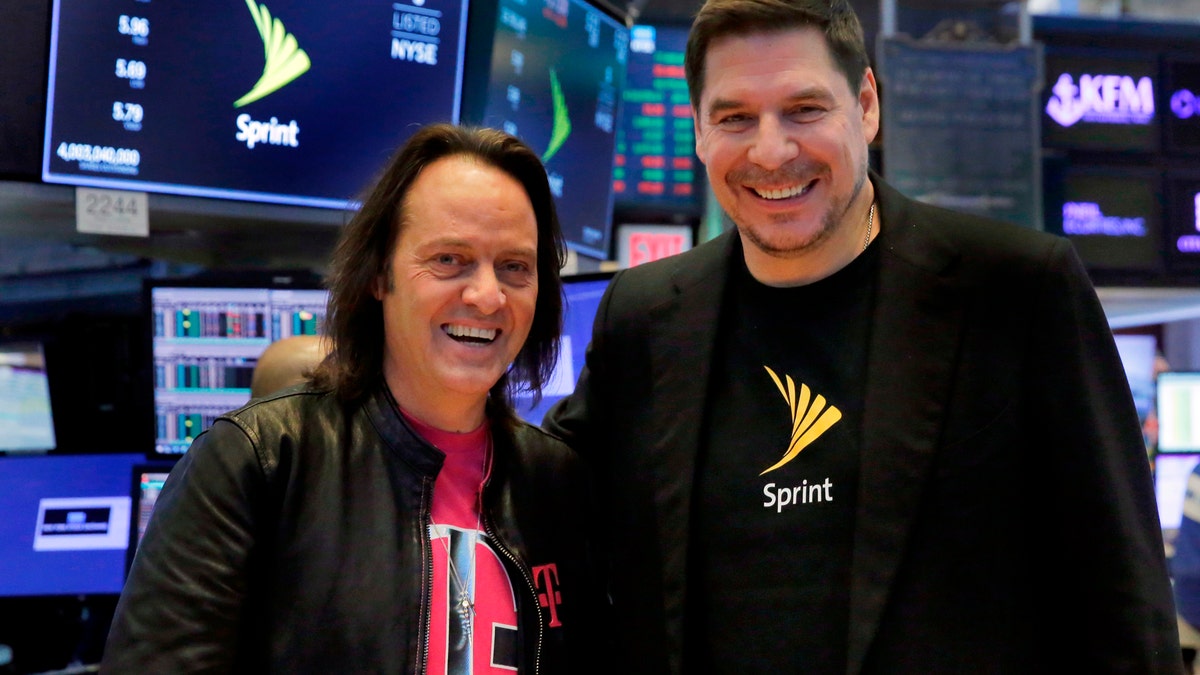
T-Mobile CEO John Legere, left, and Sprint CEO Marcelo Claure pose for photos on the floor of the New York Stock Exchange, Monday, April 30, 2018. To gain approval for their $26.5 billion merger agreement, T-Mobile and Sprint aim to convince antitrust regulators that there is plenty of competition for wireless service beyond Verizon and AT&T. (AP Photo/Richard Drew) (AP)
Sprint and T-Mobile customers won't see much technical disruption from the companies' pending merger. Rate plans, on the other hand, could take a hit.
T-Mobile has set a three-year time frame for the network merger. With most US phone owners now swapping phones in a two- to three-year window, Sprint subscribers will likely buy new phones before the network merger completes.
But if you have a relatively recent phone, you don't even have to worry about that. Provided the FCC and Department of Justice approve this merger, here's what will happen.
Goodbye, CDMA. Hello, Roaming
More From PCmag
Sprint and T-Mobile subscribers with the right phones will see immediate coverage and speed improvements after the merger.
The two carriers will start an LTE roaming agreement, letting phones belonging to one of them hop over to the other's network when they need to.
For T-Mobile phones to hop to Sprint's network, they need LTE bands 25, 26 and 41.
For Sprint phones to hop to T-Mobile, they need some combination of bands 2, 4, 12, 66, or 71. Many Sprint phones have bands 2 and 4; the others are rarer. Bands 12 and 71 are the key ones for more rural areas.
Sprint phones currently make calls on the carrier's old 2G CDMA network. Expect the carriers to push an update that lets them make calls using voice-over-LTE, and to move to shut down that old CDMA system.
Over time and as 5G phones become available, the new carrier will shift much of bands 41 (mid-band) and 71 (low-band) to 5G.
The Sprint CDMA network isn't using up spectrum that T-Mobile absolutely needs for 5G, so T-Mobile won't need to shut it down before 2021. That gives T-Mobile plenty of time to move Sprint subscribers onto the new 4G/5G system.
Will My Phone Have Better Coverage?
We made a chart of recent Apple, Samsung, and LG flagships to show which T-Mobile phones will be able to run on Sprint's network, and vice versa. Note that this chart only refers to added coverage. Your phone will keep running on your existing network for up to three years after the merger.
If you're concerned about improving your LTE coverage, look at bands 12, 26, and 71. Those are the low-frequency bands that penetrate buildings and go long distances. Bands 4 and 41 will supply great speeds in urban and suburban areas.
This chart looks a little dire for T-Mobile phones on Sprint's network, but remember, they're going to keep their T-Mobile network. It's better news for Sprint customers, who will often see added coverage and better speeds by adding T-Mobile.
On the carrier models of these devices, some frequency bands are blocked in firmware, rather than hardware. So it's possible that T-Mobile and Sprint could push firmware updates to open up each others' bands on some devices that don't currently appear to have that band support. The "merged" firmware doesn't exist yet, but it could in theory be written.
Normalizing Rates
Once the merger closes, you'll be able to keep your existing service plans, but expect price promotions to go away and rates to normalize at AT&T and Verizon's levels.
That's a big advantage of this merger: killing the price war that T-Mobile and Sprint have been in. T-Mobile execs need to promise lower prices now to get the merger approved, but once it happens, there will be serious investor pressure to push up profits.
Unlimited data will stay: that's the norm nowadays. But deals? They're likely a thing of the past. There may be some great deals offered during the merger process, as T-Mobile tries to push the narrative that it will continue to lead on prices.
What About Boost and Virgin?
The two carriers will probably slightly reduce the number of brands they're selling, but only slightly.
MetroPCS is very successful, and overlaps heavily, customer-wise, with Boost. That said, the company is likely to keep both brands because they provide the illusion of competition. Killing a successful virtual carrier wouldn't make sense for that strategy.
That also bodes well for third-party, wholesale customers like Google Fi, US Mobile, Republic Wireless, and Ting. T-Mobile really wants these companies to look like competitors, even though they really aren't. It will make sure they're kept happy enough to stay in business, but that they don't grow enough to be a real threat.
Why aren't they competition, you wonder? The big carriers control the virtual carriers' network contracts. They're structured so the virtual carriers add to the big carriers' wholesale subscriber bases without cutting too much into their retail profits. If they become too much of a threat, the big carriers have the power to rein them in.
In the case of Google Fi, Google has set guardrails on the carrier's size by strictly limiting the phones that can be used. Other prepaid, wholesale clients are charged rates that work out great for low usage, but don't make sense for high usage, unlimited data or family plans.
Virgin will probably go away. We haven't heard much about Virgin since it went down its "iPhone-only" road. The Sprint brand will go away, too, of course.
So, Don't Panic
We don't approve of this merger because it will probably lead to job losses and higher prices. But there won't be a major disruption of service for Sprint and T-Mobile customers, and in many cases, service will improve considerably.
This is the challenge with a merger like this: are you willing to trade less competition for a better network?
This article originally appeared on PCMag.com.
